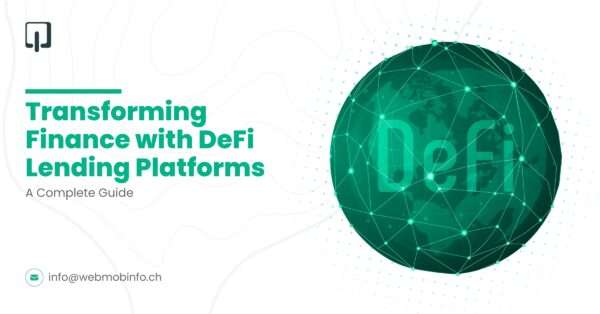Since decentralized finance (DeFi) is a relatively new sector of the global financial market, lending platforms are critical to its success. These platforms allow assets to be lent and borrowed without the participation of third parties, and they serve as a replacement for traditional financial institutions. This blog analyzes the most well-liked platforms that are ruling the market, how DeFi lending platforms operate, and how they differ from traditional lending.
TABLE OF CONTENT
What Are DeFi Lending Platforms?
DeFi lending platforms allow users and borrowers to lend and borrow cryptocurrency without going through banks or other middlemen. These platforms incorporate blockchain technology and smart contracts to protect and streamline transactions while maintaining trust and transparency.
Users of DeFi lending platforms can earn interest on their coins or take out loans by pledging some coins as collateral. These platforms operate on many blockchains, with Ethereum being the most popular. It extends financial engineering to every person with internet access, thereby democratizing finance.
Basics and Mechanisms
It is rather important to know how the DeFi lending platforms operate for anyone who plans to use the services. Here’s a breakdown of the basic mechanisms:
1. Smart Contracts
Smart contracts, which are self-executing contracts with coded stipulations, are essentially the foundation of deFi lending platforms. These contracts allocate the money and apply the regulations without the help of a third party.
2. Collateralization
To borrow money, borrowers must provide cryptocurrency as security. Because the collateral may be sold, these types of collateralizations ensure that the lenders’ money will be protected in the event of a default.
3. Interest Rates
Interest rates within the DeFi lending platforms are commonly set through an automated process using the supply and demand rate. The lenders earn interest on the deposited assets, but the borrowers pay interest on their loans.
Major benefits of DeFi lending platforms
DeFi lending platforms offer several benefits over traditional financial systems:
1. Accessibility: Decentralized finance applications are accessible to anyone with web access and digital wallets. There are no credit checks and long approvals, which make it convenient for people all over the world to get access to financial services.
2. Transparency: Recorded transactions and smart contracts are open to the public as they are stored in the blockchain. Users can easily check the transaction and learn how the specific platform works.
3. Security: Security is a very strong aspect of blockchain technology. Thus, the incorporation of smart contracts minimizes the likelihood of human mistakes and fraud, while decentralized systems eliminate the issues related to single points of failure.
4. Higher Yields: Currently, DeFi lending platforms can pay more to lenders than simple savings accounts, increasing their popularity.
DeFi vs. Traditional Lending
| Features | DeFi Lending Platforms | Traditional Lending |
| Intermediaries | No intermediaries; uses smart contracts. | Dependent on banks and other financial institutions. |
| Accessibility | Open to anyone with internet and cryptocurrency. | Affordable to those with credit scores and banking services. |
| Transparency | High and efficient based on the use of blockchain in record-keeping. | Less transparent; records and decisions are centralized. |
| Costs | Lower costs due to automated processes and lack of intermediaries. | High charges due to administration and intermediaries. |
| Security | Smart contracts minimize fraud risk; terms are immutable. | Security is highly dependent on institutions. |
| Interest Rates | Dynamic, depends on supply and demand in liquidity pools. | Fixed or variable depending on the banks. |
| Loan Approval | Automated, based on collateral provided. | Manual, based on credit history and income verification. |
Best DeFi Lending Platforms in 2024
Here are five of the best DeFi lending platforms currently available:
1. Aave
Aave is one of the most prominent DeFi lending platforms, providing a rather wide range of supported cryptocurrencies and tokens, as well as additional features. It is one of the major features of the platform that can easily switch from fixed to floating rates based on the market condition for lending or borrowing. Another revolutionary aspect of Aave is the flash loans that allow borrowers to make loans without putting their collateral, and the loans must be paid off in the same transaction.
2. Compound
Compound is a decentralized money market protocol that enables users to earn interest or borrow an asset against their crypto holdings. It works by pooling assets into liquidity pools with interest rates that are variable depending on supply and demand. One of the major advantages of Compound is that it is quite easy to understand and user-friendly, even for those who are new to DeFi.
3. MakerDAO
MakerDAO is a decentralized autonomous organization that operates through smart contracts and is involved in the generation of DAI, a stablecoin. Lenders can pledge their crypto coins into smart contracts in MakerDAO to create DAI tokens. It can be in turn utilized in other financial operations without the high volatility connected to other cryptos.
4. Nexo
Nexo is a financial hub that encompasses interest-bearing accounts with very high returns and instant crypto-backed loans. It is possible to earn daily interest on the amount of crypto coins one holds or borrow cash by depositing crypto coins as security. Thus, we can state that Nexo has a wide audience caused by its competitive interest rates and flexible terms of the loan.
5. Binance
A global cryptocurrency exchange giant, Binance, is now venturing into DeFi lending by providing a complete solution. Thus, using Binance’s services, one can earn interest on cryptocurrency holdings or use the funds to get a loan secured by digital assets. High liquidity and a vast number of supported assets make Binance more attractive to users.
Risks and Challenges in DeFi Lending
While DeFi lending platforms offer numerous benefits, they also come with inherent risks and challenges:
- Smart Contract Vulnerabilities: It is crucial to note that smart contracts’ only line of defence is the code they contain. Flaws or bugs may cause a company to lose large sums of money.
- Regulatory Uncertainty: The rules governing DeFi are not very well set and still under development. Adaptations to laws may affect the functioning and legal status of decentralized finance services.
- Market Volatility: Lending through cryptocurrencies is associated with high risks due to the fluctuation of prices in the market, and this will also impact the value of the collateral used in the lending process.
- Liquidity Risks: DeFi platforms need to have enough liquidity to function properly. Lack of liquidity can lead to slippage and increased costs for users.
Future Trends and Predictions for DeFi Lending Platforms
The future of DeFi lending platforms looks promising, with several trends likely to shape the industry:
- Integration with Traditional Finance
Speaking of the future trends for DeFi, it is possible to state that as the market develops, there will be more interaction with the centralized financial systems and deeper implementation of the best features of both worlds.
- Enhanced Security Measures
Future developments in smart contract security and blockchain technology will lead to the creation of more secure and reliable DeFi platforms.
- Expansion to Other Blockchain Platforms
Even though Ethereum remains the leading platform for DeFi, more blockchains, such as Binance Smart Chain and Polkadot, are emerging, presenting new prospects for DeFi lending platforms.
- Increased Institutional Participation
Institutional investors are also beginning to understand the possibilities of DeFi and provide money for the development of this segment.
Summing Up
Lending platforms in decentralized finance are transforming the financial landscape by providing decentralized, transparent borrowing methods through peer-to-peer lending services. All these platforms utilize blockchain technology to provide immense convenience, safety, and efficiency. With the world heading towards decentralization, DeFi lending platforms will remain relevant and will be crucial in providing finance to people globally.
At Webmob Software, we specialize in DeFi lending platform development, offering innovative solutions tailored to your specific needs. Whether you are looking to create a robust DeFi lending and borrowing platform or seeking expert guidance to navigate this dynamic space, our team is here to help you succeed. Contact us today to learn more about our top-notch DeFi lending platform development services and take the first step toward unlocking new financial possibilities.
Nitin Gupta, the CEO of WebMob Software Solutions, is a visionary leader renowned for his innovative approaches to leveraging emerging technologies to transform businesses globally. Under Nitin's guidance, WebMob has evolved into a pioneer in fintech, catering to esteemed clients across Europe, APAC, and the Middle East. As a thought leader, he continues to drive WebMob towards new heights of success, cementing its reputation as an industry leader in the IT sector.

